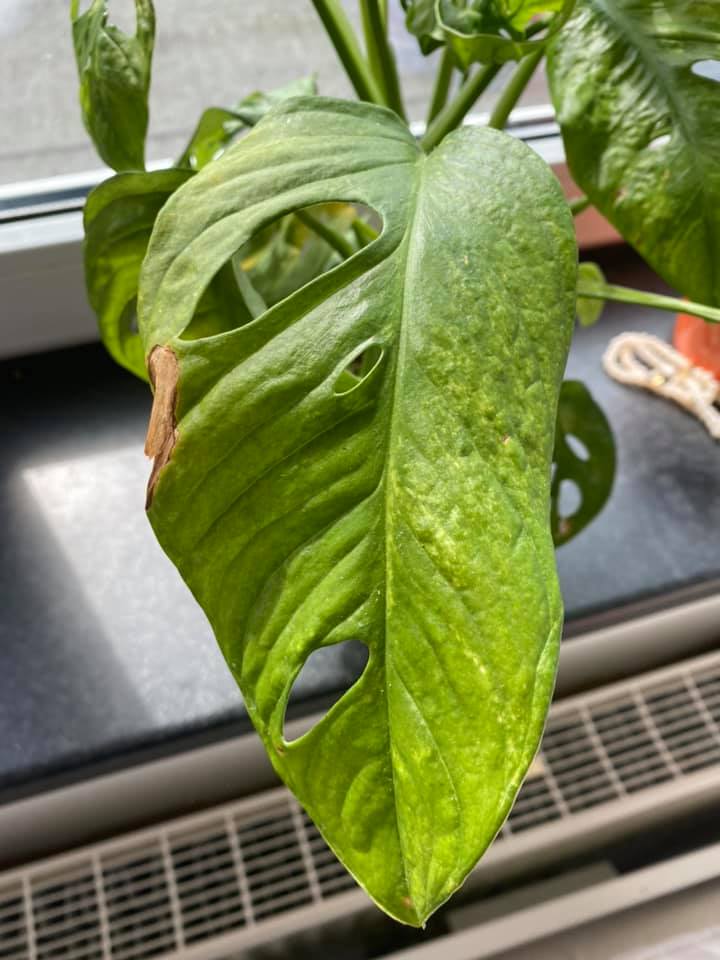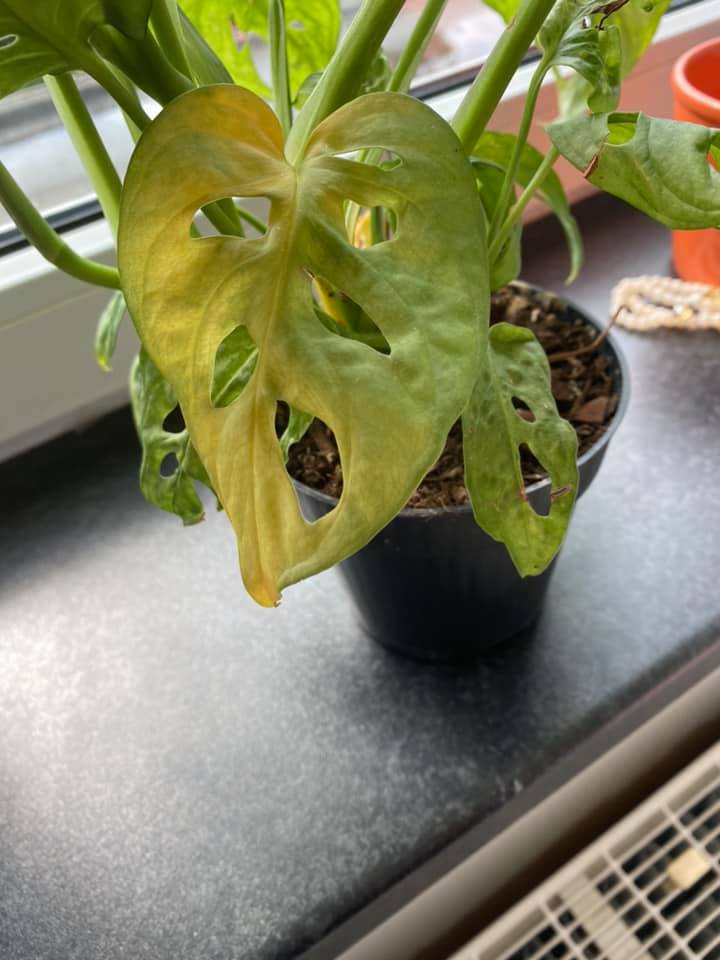Here’s a question that recently came up in our Monstera Facebook Group: What is monstera mosaic disease?
I’ve noticed a lot more online reports of this disease affecting monsteras lately, especially monstera adansonii, so let’s take a closer look at this disease and how you can prevent it.
What is monstera mosaic disease?
Mosaic disease is a group of viruses that affect many different types of plants, including monstera. Some of these viruses, such as Tobacco Mosaic Virus (TMV) and Cucumber Mosaic Virus (CMV) affect mostly nightshades and cruciferous vegetables, but other types like Dasheen Mosaic Virus (DsMV) are more likely to affect plants in the aroid family, including peace lilies, philodendrons, and monsteras.
Viruses attack the cells of organisms, and the mosaic virus is no different. Mosaic virus attacks your monstera on the cellular level, which can eventually kill your plant.

What Causes Mosaic Disease?
Like viruses that affect humans and animals, Mosaic virus is contagious and can be spread from plant to plant via insects, dirty hands and tools, infected pots and potting soil, and close proximity with other infected plants.
If your monstera touches another surface infected with mosaic virus, it may become infected. A monstera could pick up the virus in a greenhouse, at a shop, or in a home with another infected plant or where tools or hands have touched an infected plant.
The virus is also spread via insects such as aphids or spider mites, which might have walked on an infected plant. Yet another reason to nip mild insect infestations in the bud!
How to Identify Monstera Mosaic Disease
Mosaic disease can be tricky to identify on a monstera because it can look a lot like natural variegation. It also resembles the effects of certain nutrient deficiencies, overwatering, lack of sunlight, or unideal temperatures or humidity levels.
Mosaic disease causes patterned discoloration on your monstera’s leaves, which can sort of look like a mosaic. (Makes sense, right?)

The discolored parts may range from white or yellow to a lighter green against the natural green of the leaves. This discoloration may show up in spots, stripes, or a mottled pattern.
Leaves may also start to curl or otherwise deform. You may notice slowed or even halted growth. Leaf veins may also begin to yellow.
If you’re seeing discoloration, stunted growth, and leaf curling but all other conditions are good (watering, light, humidity, fertilizer, temperature, etc.), your monstera might have a mosaic virus.
How to Treat Mosaic Virus
Here’s the bad news: there’s no treatment for mosaic disease because it’s a virus, which can’t be killed in any way that won’t kill your plant first. (Remember your 4th grade health class where you learned that bacteria can be killed but viruses can’t? Same deal here.) You can’t just apply some neem oil or repot in fresh soil and expect the problem to go away. Once mosaic virus shows up on your plant, it’s almost certainly a goner.
If you are able to completely quarantine a sick plant with an early case of mosaic virus, you may be able to remove the infected parts with clean hands and tools (make sure to wash your hands before touching any other plants or surfaces). There’s a slight chance this could work if the virus isn’t already in the pot and soil.
Otherwise, the only thing to do is to destroy the infected monstera. (I know, getting rid of a sick plant is heartbreaking!) Avoid throwing the plant in a compost pile or anywhere else it could eventually come in contact with other plants and soil because that will only spread the virus. Then, wash your hands before touching other plants or surfaces.
How to Prevent Mosaic Virus
Since treatment is nearly impossible, prevention is key for keeping your plants safe from mosaic virus.

Try these tips for prevention:
- Before bringing a monstera home from the store, inspect it and neighboring plants for signs of disease. Make sure to have a walk around to see if the other plants generally look healthy or if there seems to be a lot of health problems going on.
- When you bring your new monstera (or any other plant home) it’s a good idea to quarantine it away from other plants for a few weeks to see if any diseases or insect problems manifest. That way, you can deal with the problem in isolation instead of infecting your other plants.
- If you’re buying a monstera online, be sure to read seller reviews to see if their plants have a history of disease.
- Only use clean pots and fresh potting medium to pot your monstera.
- Wash and sterilize all tools such as trowels and pruning shears after use to prevent spreading viruses or bacteria from plant to plant.
- Wash your hands before handling your monstera, and between handling different plants.
Luckily, mosaic virus is rare in indoor plants, so hopefully you’ll never have to deal with this. It’s always a good idea to practice good plant hygiene to keep all your plant babies healthy and prevent diseases such as this. Better safe than sorry!
For more tips for growing a happy, healthy monstera, try these articles:
The Easy Way to Protect Your Monstera’s Leaves





